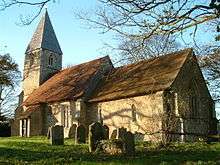St Mary's Church, Chickney
| St Mary's Church, Chickney | |
|---|---|
 St Mary's Church, Chickney, from the southeast | |
 St Mary's Church, Chickney Location in Essex | |
| Coordinates: 51°55′43″N 0°17′18″E / 51.9287°N 0.2882°E | |
| OS grid reference | TL 575 280 |
| Location | Chickney, Essex |
| Country | England |
| Denomination | Anglican |
| Website | Churches Conservation Trust |
| History | |
| Dedication | Saint Mary |
| Architecture | |
| Functional status | Redundant |
| Heritage designation | Grade I |
| Designated | 20 February 1967 |
| Architectural type | Church |
| Style | Saxon, Gothic |
| Groundbreaking | 10th–11th century |
| Completed | Early 15th century |
| Specifications | |
| Materials |
Flint rubble with limestone and clunch dressings Tiled roofs, timber porch |
St Mary's Church is a redundant Anglican church in the parish of Chickney, Essex, England. It is recorded in the National Heritage List for England as a designated Grade I listed building,[1] and is under the care of the Churches Conservation Trust.[2]
History
St Mary's dates from a time before the Norman conquest, from either the late 10th or the early 11th century.[1][2] The church is recorded in the Domesday Book.[3] The chancel was extended during the reign of Henry III,[2] and the tower was built in the 14th century.[1] The south porch was added in the early 15th century.[1]
Architecture
Exterior
The church is constructed in flint rubble, with limestone and clunch dressings. The roofs have red tiles and the porch is timber. Its plan consists of a nave with a south porch, a chancel, and a west tower.[1] The architectural style of the nave and chancel is Saxon, and the rest of the church is Gothic.[2] The tower is in three stages, with diagonal buttresses on the west side and a pyramidal roof. Also on the west side is a restored window. In the top stage there are two-light bell openings on each face. The nave contains a doorway from the 14th century, and windows pre-dating the Norman conquest. The windows in the chancel are lancets from the early 13th century, and a 15th-century squint is also present.[1]
Interior
The king post roof dates from the early 14th century. The font is also from the 14th century, and it has a 16th-century cover. The piscina, with a trefoil head, is from the early 13th century.[1] The pulpit is Georgian.[2]
See also
References
- 1 2 3 4 5 6 7 Historic England, "Church of St Mary the Virgin, Chickney (1112190)", National Heritage List for England, retrieved 9 February 2014
- 1 2 3 4 5 St Mary's Church, Chickney, Essex, Churches Conservation Trust, retrieved 1 December 2016
- ↑ Chickney, St Mary's Church, Britain Express, retrieved 4 December 2010